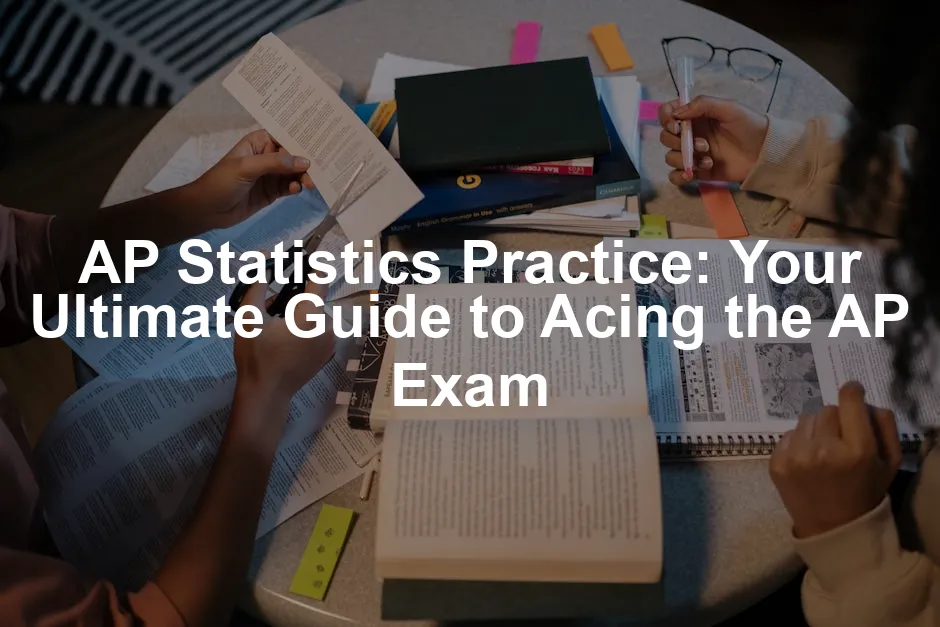Introduction
AP Statistics is a pivotal Advanced Placement course that sets the stage for college-level statistics. It’s not just about crunching numbers; it’s about understanding data and making informed decisions based on that data. This course equips students with essential skills for interpreting quantitative information, an invaluable asset in today’s data-driven world.
Practicing for the AP exam is crucial. Why? Familiarity with the exam format and question types can make a world of difference on test day. You wouldn’t want to walk into a lion’s den without knowing how to handle a lion, right? The AP Statistics exam consists of multiple-choice and free-response sections. Each section has its own quirks, and understanding these can help you tackle the exam with confidence.
In this blog post, we’ll break down everything you need to know to ace the AP Statistics exam. We’ll dive into the exam format, explore practice resources, share effective test-taking strategies, and address frequently asked questions. By the end, you’ll be armed with the knowledge and tools to approach your exam with confidence.
Ready to conquer that exam? Let’s get started!
Understanding the AP Statistics Exam Format
Overview of the Exam Structure
The AP Statistics exam is structured into two main parts: the multiple-choice section and the free-response section. Each section plays a crucial role in determining your overall score.
The multiple-choice section consists of 40 questions to be completed in 90 minutes. You’ll need to read each question carefully and choose the best answer from five options. This section tests your understanding of core concepts and your ability to apply statistical reasoning.
Following that, you’ll tackle the free-response section, which lasts for another 90 minutes. This part includes five short-answer questions and one investigative task, allowing you to showcase your analytical skills in a more open-ended format. Here, you’ll need to show your work, explain your reasoning, and justify your conclusions.
Both sections are weighted equally in the overall scoring. Therefore, it’s vital not to neglect either part. Mastering the multiple-choice questions can boost your confidence, while excelling in the free-response section can help you stand out.
Understanding the exam structure is your first step towards success. With this knowledge, you can approach your study sessions with a clear focus and strategy. Now that you’re familiar with the format, it’s time to explore the content areas that will be tested.

Where to Find Practice Exams and Resources
Official Practice Exams
When it comes to preparing for the AP Statistics exam, using official College Board resources is as essential as a well-timed coffee break during a late-night study session. These resources are the crème de la crème, offering the most accurate reflection of what you’ll encounter on exam day.
First up, let’s talk about the 2012 AP Statistics Released Exam. This gem includes a full-length practice test with real questions from previous years. You get a sneak peek into the exam’s structure and the types of questions that could pop up. Plus, it comes with an answer key and scoring information, just to keep you on your toes.
Another treasure is the 1997 AP Statistics Released Exam. While it may be a blast from the past, don’t underestimate its value! Even though the exam format has changed slightly, the core concepts tested remain relevant. It’s a fantastic way to practice your statistical skills. Again, you’ll find an answer key and scoring details, which are crucial for understanding how your performance stacks up.
To access these official resources, head over to the College Board’s website. Here are the links to get you started:
Incorporating these official practice exams into your study routine can provide a significant boost to your confidence and readiness. So, grab your favorite snack, settle in, and tackle these exams!

Unofficial Practice Resources
When it comes to preparing for the AP Statistics exam, unofficial practice resources can be a game-changer. They offer a variety of tools that cater to different learning styles. Here are some popular platforms you might want to consider:
- Varsity Tutors: This platform provides a treasure trove of flashcards and tests, all organized by topic. Whether you’re struggling with probability or statistical inference, their resources can help you reinforce your understanding. Plus, the flashcards make for a quick and fun way to quiz yourself!
- Stat Trek: If you’re after interactive multiple-choice tests, Stat Trek is your go-to. Their practice exams mimic the real deal, enabling you to experience the pressure of timed questions. It’s like a dress rehearsal for the big day!
- Albert.io: For those looking for a more comprehensive approach, Albert.io offers extensive question banks, though a subscription is required. If you’re willing to invest a bit, this resource provides a structured way to tackle all the major topics.
In addition to these platforms, don’t overlook the value of free-response practice tests and diagnostic quizzes. These types of assessments can help you pinpoint your strengths and weaknesses, making your study sessions more efficient.

Mock Exams and Live Practice Tests
Mock exams are a fantastic way to prepare for the AP Statistics exam. Institutions like Iowa State University offer these invaluable experiences. Participating in a mock exam gives you a taste of what to expect on test day, from the types of questions to the overall exam atmosphere.
Feedback from past participants often highlights the effectiveness of these mock exams. Many students report feeling more confident after their practice, as they gain insights into which topics need more attention. One student noted, “The Mock Exam helped me understand what concepts I needed to review,” while another mentioned, “The immediate feedback after the test was a game-changer.”
These experiences not only boost your confidence but also help you develop a solid strategy for tackling the actual exam. So, if you have the opportunity, don’t pass it up!

Creating a Study Plan
Crafting a study schedule is your golden ticket to acing the AP Statistics exam. Start by breaking your study time into manageable chunks. Aim for short, focused sessions; think of it as snacking rather than a buffet. A Study Planner Notebook can help you keep track of your goals and progress!
Begin by assessing your current knowledge. Identify which topics need more attention. Allocate more time to those tricky areas, while still touching on everything. A balanced approach keeps you from feeling overwhelmed.
Don’t forget to practice both multiple-choice and free-response questions. Set aside specific days for each type. This way, you’ll get a feel for the exam structure. Mixing it up keeps your brain engaged and avoids the monotony of studying the same format repeatedly.

Test-Taking Strategies
Multiple-Choice Tips: When confronting multiple-choice questions, your first move should be to eliminate the obviously wrong answers. This narrows your options. If you’re left with a couple of choices, make an educated guess. Trust your instincts; sometimes the first thought is the right one!
Free-Response Tips: Free-response questions can feel daunting. Start by clearly showing your work. Neatness counts! Organize your answers logically. Don’t rush; take the time to think through the problem. Managing your time is crucial. Allocate enough minutes for each question, leaving some for review.
Understanding the scoring guidelines is vital. Familiarize yourself with how points are awarded. This knowledge can guide your responses, ensuring you maximize your score.

Utilizing Flashcards and Study Groups
Flashcards are your best friends for memorizing key terms and formulas. Create a set with definitions, concepts, and sample problems. They’re perfect for quick reviews or those moments when you need a break from heavier studying. You can find great Flashcards for AP Statistics on Amazon!
Study groups can be a game changer. Collaborating with peers provides motivation and different perspectives on challenging topics. You can quiz each other and share valuable resources. Plus, explaining concepts to others reinforces your understanding. It’s like teaching, but with less pressure!
By employing these strategies, you’re not just preparing for an exam; you’re building a solid foundation for future statistical endeavors.

Reviewing Scoring Guidelines
Understanding scoring rubrics is crucial for AP Statistics success. These guidelines reveal how free-response questions are graded. Familiarity with these rubrics helps students tailor their answers to maximize points. Each question has specific criteria, and knowing these can give you a leg up.
Analyzing past exam performances is equally important. By reviewing previous tests, students can spot strengths and weaknesses. Did you ace the probability questions but struggle with statistical inference? Recognizing these patterns allows you to focus your study efforts. Use this feedback to guide your practice sessions and improve your overall performance.

Sample Questions and Solutions
Let’s look at a few sample questions from past AP Statistics exams.
Multiple-Choice Question:
Which of the following is true about a normal distribution?
– A) It is always skewed to the right.
– B) The mean is greater than the median.
– C) It is symmetric around the mean.
– D) The standard deviation is always zero.
Solution:
The correct answer is C. A normal distribution is symmetric around the mean, making this option true.
Free-Response Question:
A researcher wants to investigate the effect of a new medication on blood pressure. Design an experiment, detailing the sample selection and data collection methods.
Solution:
To conduct this experiment, use a randomized control trial. Select a diverse sample of participants with varying blood pressure levels. Randomly assign half to receive the medication and half a placebo. Measure blood pressure before and after the treatment period. Analyze the data using a paired t-test to determine if there is a significant difference between the two groups.
This approach not only showcases statistical reasoning but also demonstrates a solid understanding of experimental design.

Conclusion
In summary, practicing for the AP Statistics exam is key. Reviewing scoring guidelines helps you understand how your work will be evaluated. Analyzing past performances allows you to identify areas needing improvement. By practicing sample questions, you become familiar with the exam format, boosting your confidence.
Utilize the resources mentioned throughout this post. From official practice exams to mock tests, each tool offers unique benefits. Consistent practice is essential for mastering the content and honing your skills. Remember, preparation is not just about hard work; it’s about smart work.
Stay curious, engage with the material, and keep practicing. With dedication, you’ll be well on your way to acing the AP Statistics exam. And don’t forget to keep your study area organized with a Desk Organizer to help you stay focused!

FAQs
Common Questions About the AP Statistics Exam
How do I register for the AP Statistics exam?
To register, visit the College Board website. You’ll need to select your school and complete the registration form. Be mindful of deadlines, which typically fall in the spring before the exam.
When are AP Statistics exam scores released?
Scores are usually available in mid-July. Check the College Board’s website for specific dates and updates on score releases.
What is the best way to prepare for the free-response section?
Practice is key! Work through past free-response questions and familiarize yourself with the scoring guidelines. Focus on showing your work clearly and logically.
Can I retake the AP Statistics exam?
Yes, students can retake the exam. However, colleges may see both scores on your transcripts. It’s wise to check with potential colleges about their policies regarding retaking AP exams.
How do I register for the AP Statistics exam?
To register, visit the College Board website. You’ll need to select your school and complete the registration form. Be mindful of deadlines, which typically fall in the spring before the exam.
When are AP Statistics exam scores released?
Scores are usually available in mid-July. Check the College Board’s website for specific dates and updates on score releases.
What is the best way to prepare for the free-response section?
Practice is key! Work through past free-response questions and familiarize yourself with the scoring guidelines. Focus on showing your work clearly and logically.
Can I retake the AP Statistics exam?
Yes, students can retake the exam. However, colleges may see both scores on your transcripts. It’s wise to check with potential colleges about their policies regarding retaking AP exams.
For a comprehensive understanding of the AP Statistics exam, refer to the AP statistics formula sheet, which is an invaluable resource for your preparation.
And don’t forget to keep some Study Snacks Variety Pack handy to fuel your brain during those long study sessions!
Please let us know what you think about our content by leaving a comment down below!
Thank you for reading till here 🙂
Understanding the differences in inferential statistics vs descriptive statistics in data interpretation can greatly enhance your ability to analyze data effectively for the AP exam.
All images from Pexels




